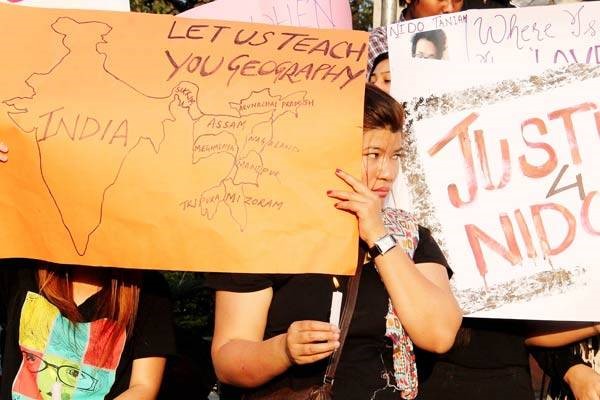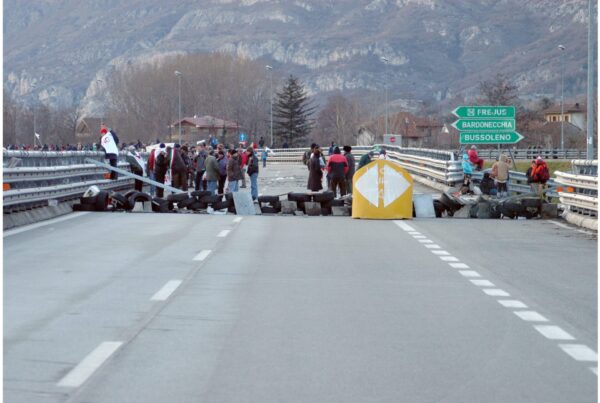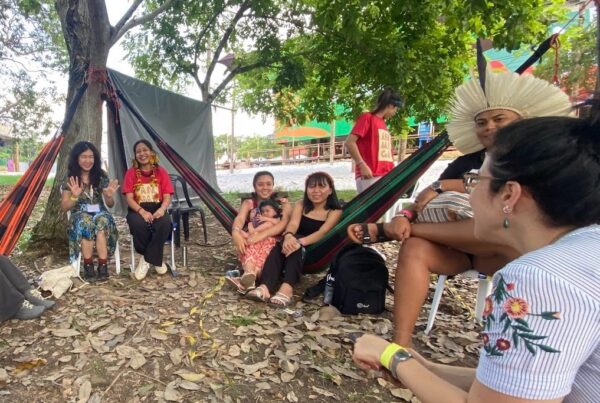By Mabel Gergan *
Mabel Gergan reflects on the shifting relationship between the Indian State and its North-Eastern and Himalayan frontier, exploring the colonial roots of racial discrimination in Indian cities and activist critiques of ongoing development interventions in the region.

Students hold up a provocative poster during a protest rally in New Delhi. Source: Times of India.
“The subject of the state is caught and impaled between the longing for justice and care and the despair of its indefinite deferral” – Anna Secor, Between longing and despair: state, space, and subjectivity in Turkey (2007, p. 28)
On January 30, 2014, 19-year old Nido Taniam, a student from Arunachal Pradesh, a mountainous borderland state in North-East India, died after being violently beaten by shopkeepers in Delhi. The shopkeepers allegedly “mocked him for his longish, stylised, dyed hair, effeminate clothing and East Asian physical features, by reportedly calling him ‘chinki’.” Most Indians from urban lowlands associate the facial features of people from the Himalayan states (including North-East India) with East Asia, Nepal or Tibet and hence consider them as outsiders or even foreign tourists.
Annually thousands of student’s flood India’s metropolitan cities in pursuit of higher education but for those marked as racial ‘others’, the transition to city life is significantly more precarious. Taniam’s death sparked protests and was a tragic reminder of the exclusion felt by people from the mountainous peripheries of India. The poster above boldly proclaims, “Let us teach you geography”, signaling how this region and its people are consistently excluded from the national imaginary. For Nido Taniam and many others from the Himalayan region, their bodies mark them as not quite of the nation, at the margins of citizenship and belonging.
The quote at the beginning of this post is from a beautifully written article by geographer Anna Secor, where she describes how the Turkish ‘strong state’ is experienced by citizens from different social groups. She argues that while most citizens’ relationship with state authority is marked by guilt, “some are more guilty than others, and, in this inequality, difference enters into the process of subjection.” (p.33)
To illustrate Secor’s argument: being pulled over by the police regardless of your social position is an unpleasant experience, marked by an overwhelming sense of guilt. But in the U.S., for instance, being pulled over as a person of color, a woman, a transgender person, or an undocumented immigrant, is significantly more precarious and highlights the “inequality” of guilt for citizens from different social groups.
Difference, in the case of Nido Taniam, was not just a matter of his phenotype but the stereotypes associated with it, i.e. someone who is a “backward, head-hunter, sexy, chinky”. These stereotypes did not appear out of thin air but have roots in colonial systems of categorization, which viewed highland frontier people as ethnically and racially distinct from lowland populations, producing an oppositional binary between the hills and the plains.

Colonial systems of classification worked to create stereotypes of different social groups, whereby some were seen as “wild”, others as warriors, while still others as noble savages. Source: Das Studios, Darjeeling.
Po’dar and Subba argue that Indian anthropologists studying the Himalayan region have contributed to a “Home-grown Orientalism”, which reproduces colonial stereotypes of the region and its people as primitive and backwards. Even today, the Himalayan frontier evokes visions of a remote, exotic, and mysterious place, an understanding that is then mapped onto the inhabitants of this region. (The term ‘frontier’ here signals how this region exists at the geographic, political, and cognitive margins of the Indian state). The experiences of Himalayan and North-Eastern students in Indian cities need to be situated in this historical context.
Within political ecology, scholars attempting to understand the relationship between the state and minority groups in the context of environmental degradation or conflicts, have also had to grapple with historical representations and essentialism of specific environments and their inhabitants. A deeper understanding of this ‘home-grown orientalism’ can also offer insights into paternalistic attempts by the Indian state to ‘develop’ these ‘unruly’ frontier regions.
In the last decade, large scale infrastructural development, especially large dams and highways, have been promoted to develop the North-Eastern region from a frontier to an economic corridor to South-East Asia, as a counter-weight to China’s geo-political dominance in the region.

Environmental degradation caused by large dams in Sikkim has resulted in protests from both local and outside environmental activists. Source: savedzongu.wordpress.com.
However, regional experts have noted that despite the emphasis on large scale infrastructure, more basic infrastructure like roads, schools, and colleges remain dismal – a result of several decades of neglect and uneven regional development. This lack of everyday infrastructure is an important factor in the migration of young people from this region to Indian cities.
While this migration is not a recent development, incidents of racial discrimination and violence have sharpened both media and scholarly attention to the experiences of these young people in Indian cities. It is important to note, however, that these experiences of exclusion have not led to a rejection of the state. If anything, they have resulted in more forceful demands for inclusion. During protests after Nido Taniam’s death, young people from the region demanded recognition as Indians and not outsiders, calling on the state to take action on their behalf.
These demands mirror in part those made by environmental activists in the North-East and Himalayan region struggling against state-led development like hydropower projects. My doctoral research examined an anti-dam movement led by indigenous youth of the Lepcha tribe in Sikkim, an Eastern Himalayan state. During fieldwork in 2013-14, members of the anti-dam movement made a decision that surprised many: they decided to enter the political arena as candidates during the state elections. Many read this decision as a betrayal of the more radical anti-state intentions of the social movement. However, it was their very exclusion from environmental and political decision-making processes that forced Lepcha anti-dam activists to participate in the electoral process.

Students hold signs as part of a campaign to generate awareness about racism against people from North-East Indian states. Source: kanglaonline.com.

Young people from the Dzongu reserve in North Sikkim led a three-year long relay hunger strike against large dams. Source: savedzongu.wordpress.com.
Given the historically fraught relationship between this region and the Indian state, these demands for inclusion signal a reorientation of the terms on which frontier citizens negotiate with the state. Both anti-dam activists in Sikkim and students protesting against racism in Delhi are caught between a certain longing and despair for the Indian state, a state that consistently excludes them from its vision of development and citizenship.
The entry of the Indian state into the margins through development projects, and the migration of young people from the margins to Indian cities – two related yet oppositional trends – is a crucial yet missing piece of how we are to understand the shifting relationship between the Himalayan frontier and the Indian state. Attending to these processes can shed light on how a nation-state incorporates those at the geographic and cognitive margins, and how those at the margins resist and desire these changes.
* Mabel Gergan is a postdoctoral research associate in the Department of Geography at the University of North Carolina at Chapel Hill. Her doctoral project studied the intersection of dams, hazards, and indigenous youth politics in the Eastern Himalayan state of Sikkim. Her postdoctoral project builds on collaborative work with Dr. Sara Smith on the education-driven migration of Himalayan youth.





